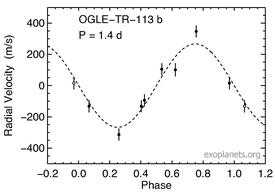OGLE-TR-113b
| Extrasolar planet | List of extrasolar planets | |
|---|---|---|
 | ||
| Parent star | ||
| Star | OGLE-TR-113 | |
| Constellation | Carina | |
| Right ascension | (α) | 10h 52m 24.40s |
| Declination | (δ) | −61° 26′ 48.5″ |
| Distance | 1800 ± 100 ly (550 ± 30[1] pc) | |
| Spectral type | K | |
| Orbital elements | ||
| Semimajor axis | (a) | 0.0229 ± 0.0002[2] AU |
| Eccentricity | (e) | 0[2] |
| Orbital period | (P) | 1.4324757 ± 0.0000013[2] d |
| Inclination | (i) | 88.8[2]° |
| Physical characteristics | ||
| Mass | (m) | 1.32 ±0.19 MJ |
| Radius | (r) | 1.09 ±0.03 RJ |
| Discovery information | ||
| Discovery date | transit found in 2002, proved to be a planet on 14 April 2004[3] | |
| Discoverer(s) | Konacki et al.[3] | |
| Discovery method | Transit[3] | |
| Discovery site | ||
| Discovery status | Confirmed[3] | |
| Database references | ||
| Extrasolar Planets Encyclopaedia | data | |
| SIMBAD | data | |
| Exoplanet Archive | data | |
| Open Exoplanet Catalogue | data | |
OGLE-TR-113b is an extrasolar planet orbiting the star OGLE-TR-113.
In 2002 the Optical Gravitational Lensing Experiment (OGLE) detected periodic dimming in the star's light curve indicating a transiting, planetary-sized object.[4] Since low-mass red dwarfs and brown dwarfs may mimic a planet, radial velocity measurements were necessary to calculate the mass of the body. In 2004, the object was proved to be a new transiting extrasolar planet.[3]

The planet has a mass 1.32 times that of Jupiter. Since the planet's inclination is known, the value is exact. It orbits the star (OGLE-TR-113) in an extremely close orbit, even closer than the famous planets 51 Pegasi b and HD 209458 b. The planet races around the star every 1.43 days. The radius of the planet is only 9% larger than Jupiter's, despite the heating effect by the star. Planets of its kind are sometimes called "super-hot Jupiters".[2]
See also
- OGLE-TR-132b
- List of extrasolar planets
References
- ↑ Díaz, Rodrigo F. et al. (2007). "Millimagnitude Photometry for Transiting Extrasolar Planetary Candidates. II. Transits of OGLE-TR-113-b in the Optical and Near-IR". The Astrophysical Journal 660 (1): 850–857. arXiv:astro-ph/0701345. Bibcode:2007ApJ...660..850D. doi:10.1086/512721.
- ↑ 2.0 2.1 2.2 2.3 2.4 Gillon, M. et al. (2006). "High accuracy transit photometry of the planet OGLE-TR-113b with a new deconvolution-based method". Astronomy and Astrophysics 459 (1): 249–255. arXiv:astro-ph/0606395. Bibcode:2006A&A...459..249G. doi:10.1051/0004-6361:20065844.
- ↑ 3.0 3.1 3.2 3.3 3.4 3.5 Konacki, Maciej et al. (2004). "The Transiting Extrasolar Giant Planet around the Star OGLE-TR-113". The Astrophysical Journal Letters 609 (1): L37–L40. arXiv:astro-ph/0404541. Bibcode:2004ApJ...609L..37K. doi:10.1086/422600.
- ↑ Udalski, A. et al. (2002). "The Optical Gravitational Lensing Experiment. Planetary and Low-Luminosity Object Transits in the Carina Fields of the Galactic Disk". Acta Astronomica 52 (4): 317–359. arXiv:astro-ph/0301210. Bibcode:2002AcA....52..317U.
External links
![]() Media related to OGLE-TR-113 b at Wikimedia Commons
Media related to OGLE-TR-113 b at Wikimedia Commons
- "OGLE-TR-113 b". Exoplanets.
Coordinates: ![]() 10h 52m 24.40s, −61° 26′ 48.5″
10h 52m 24.40s, −61° 26′ 48.5″